Archive
Fred Stein
- Fred
- Stein
Alfred Stein
- 03-07-1909
- Dresden (DE)
- 27-09-1967
- New York City (US)
- PhotographerLawyer
Always accompanied by his camera, the German émigré photographer Fred Stein discovered New York City during the 1940s and 1950s. His pictures provide an human and multifaceted view of the metropolis.
Word Count: 31

Fred Stein, Self-portrait, 1941 (© Fred Stein Archive). 
Fred Stein, El at Water Street, 1946 (© Fred Stein Archive). 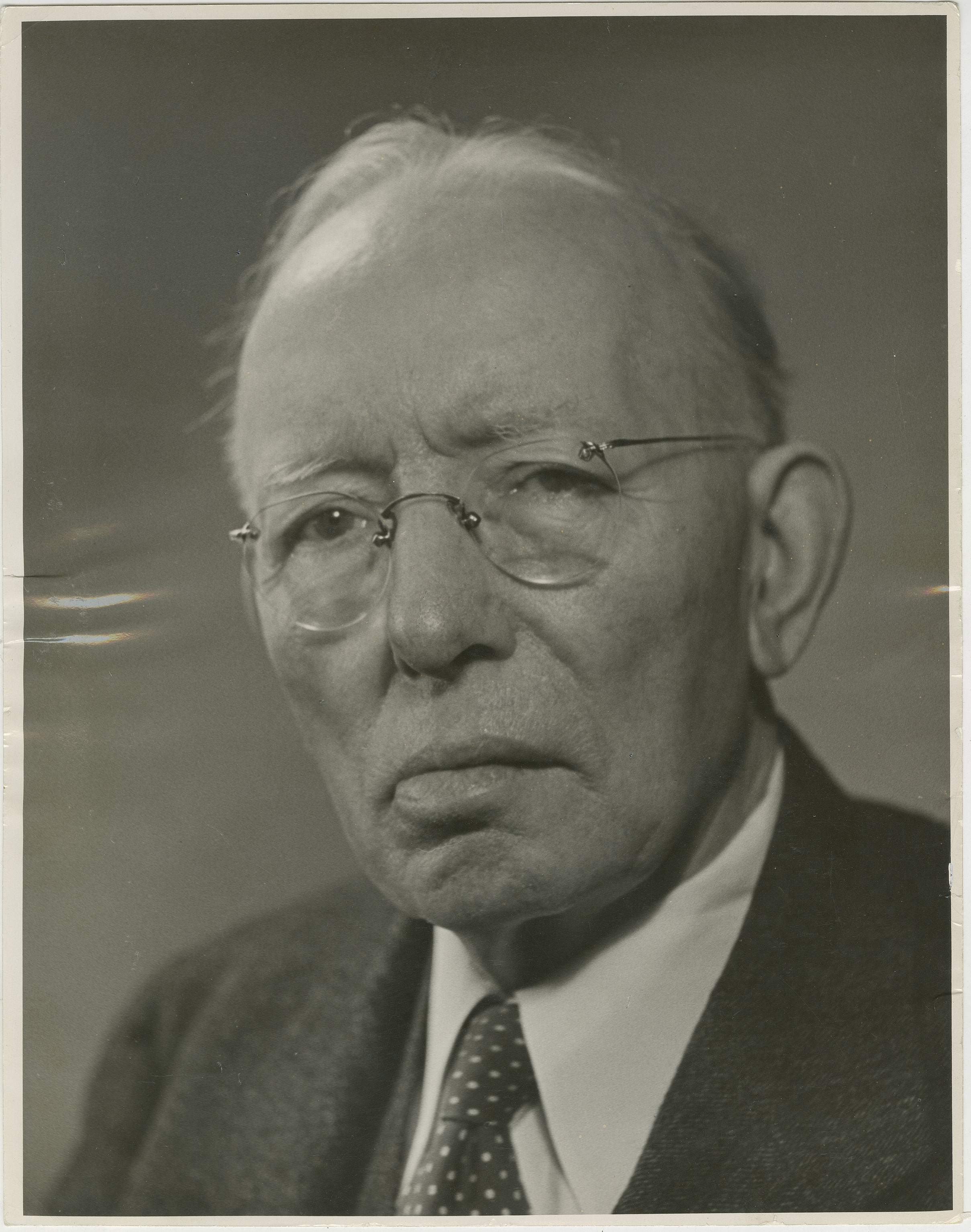
Portrait Alvin Saunders Johnson by Fred Stein, New School for Research Archive, Photograph Collection (© Fred Stein Archive). 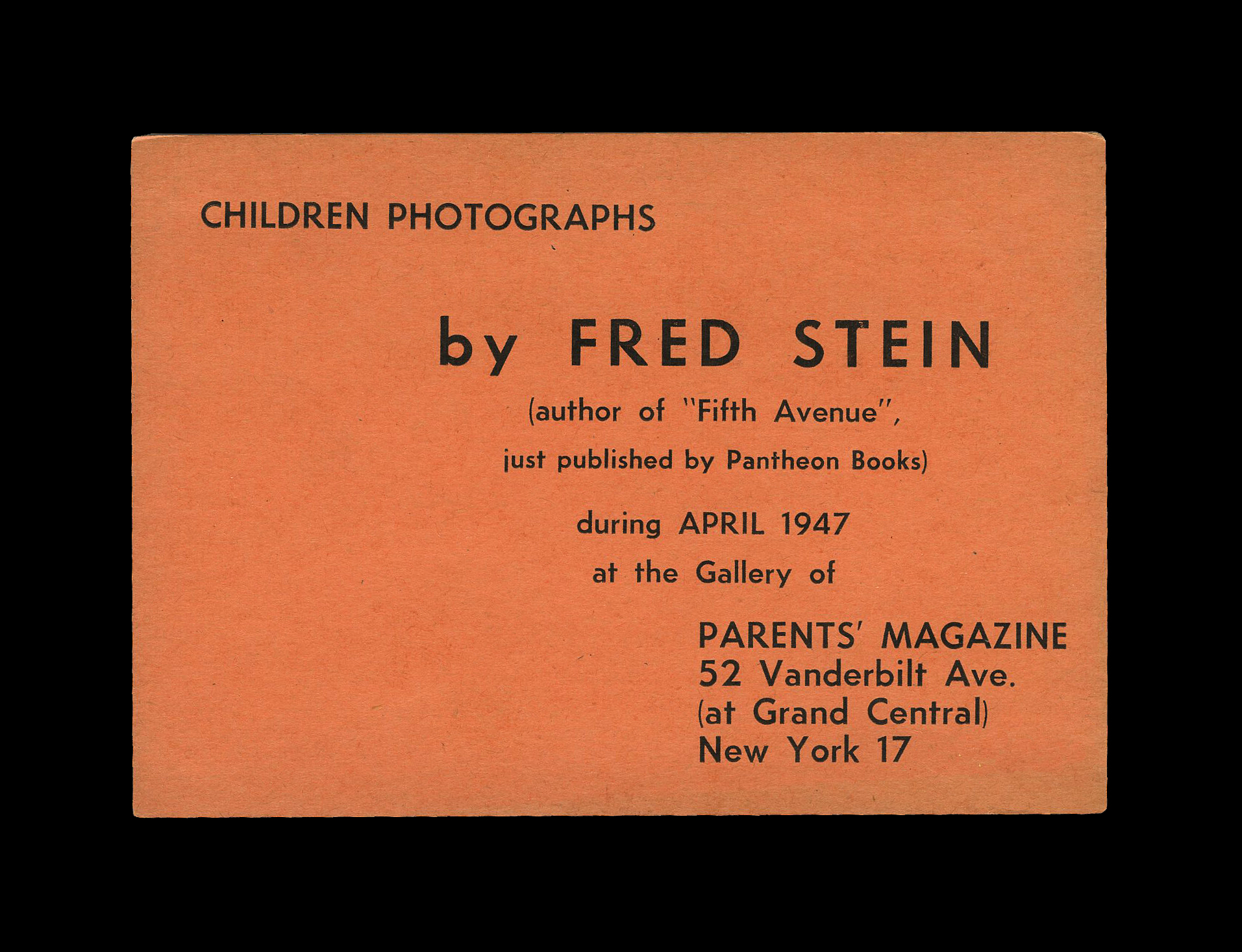
Children Photographs exhibition by Fred Stein, April 1947 (© Fred Stein Archive). 
Affidavit in Lieu of Passport (© Fred Stein Archive). 
Fred Stein, Anette Kolb, New York, 1945 (© Fred Stein Archive). 
Fritz Neugass. “The saga of the S.S. Winnipeg.” Modern Photography, July 1951, pp. 72–73 (Photo: Helene Roth). 
Black Star contract by Fred Stein, April 1, 1944 (© Fred Stein Archive). 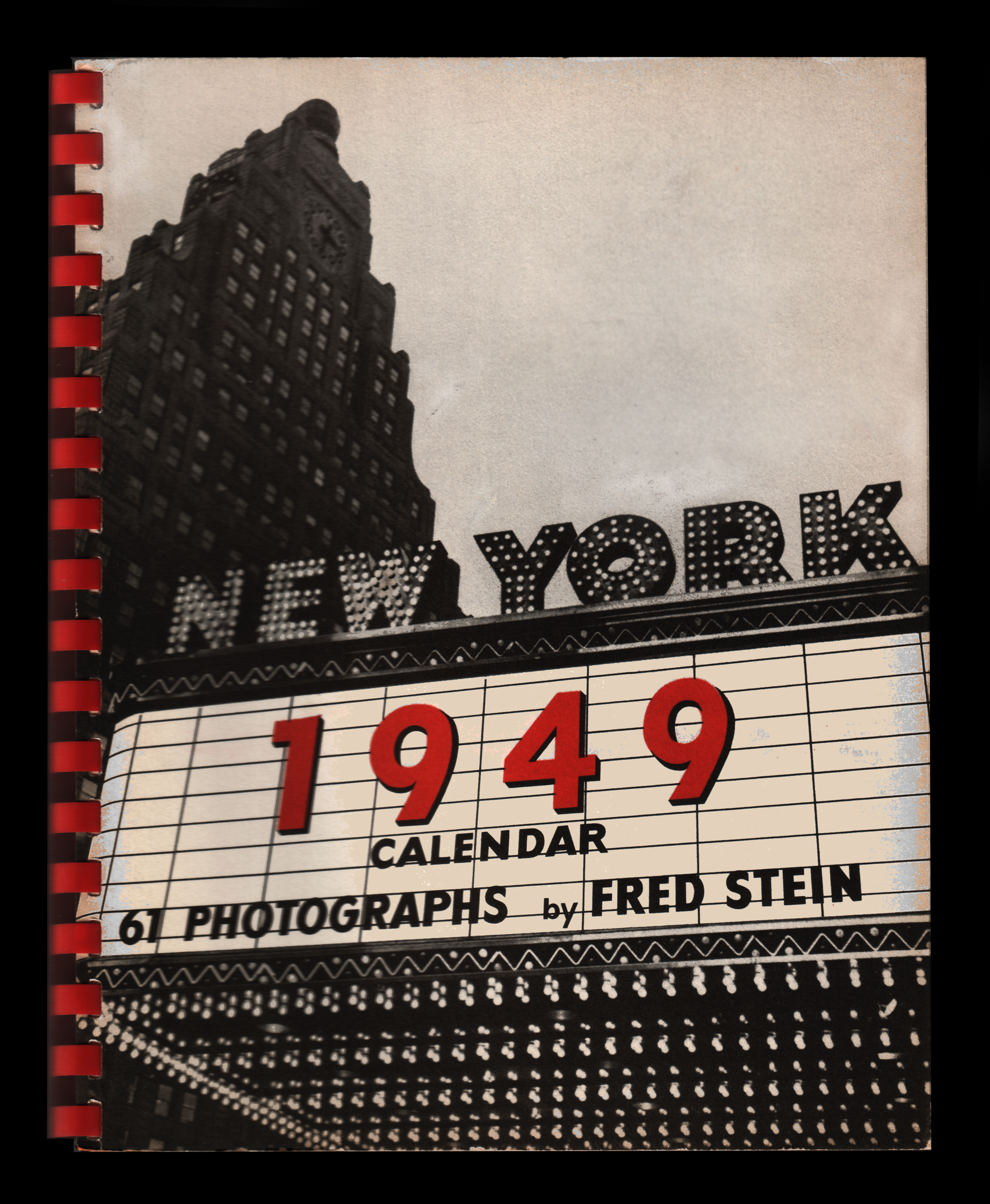
New York 1949 calendar by Fred Stein, Lumen Publisher (© Fred Stein Archive). 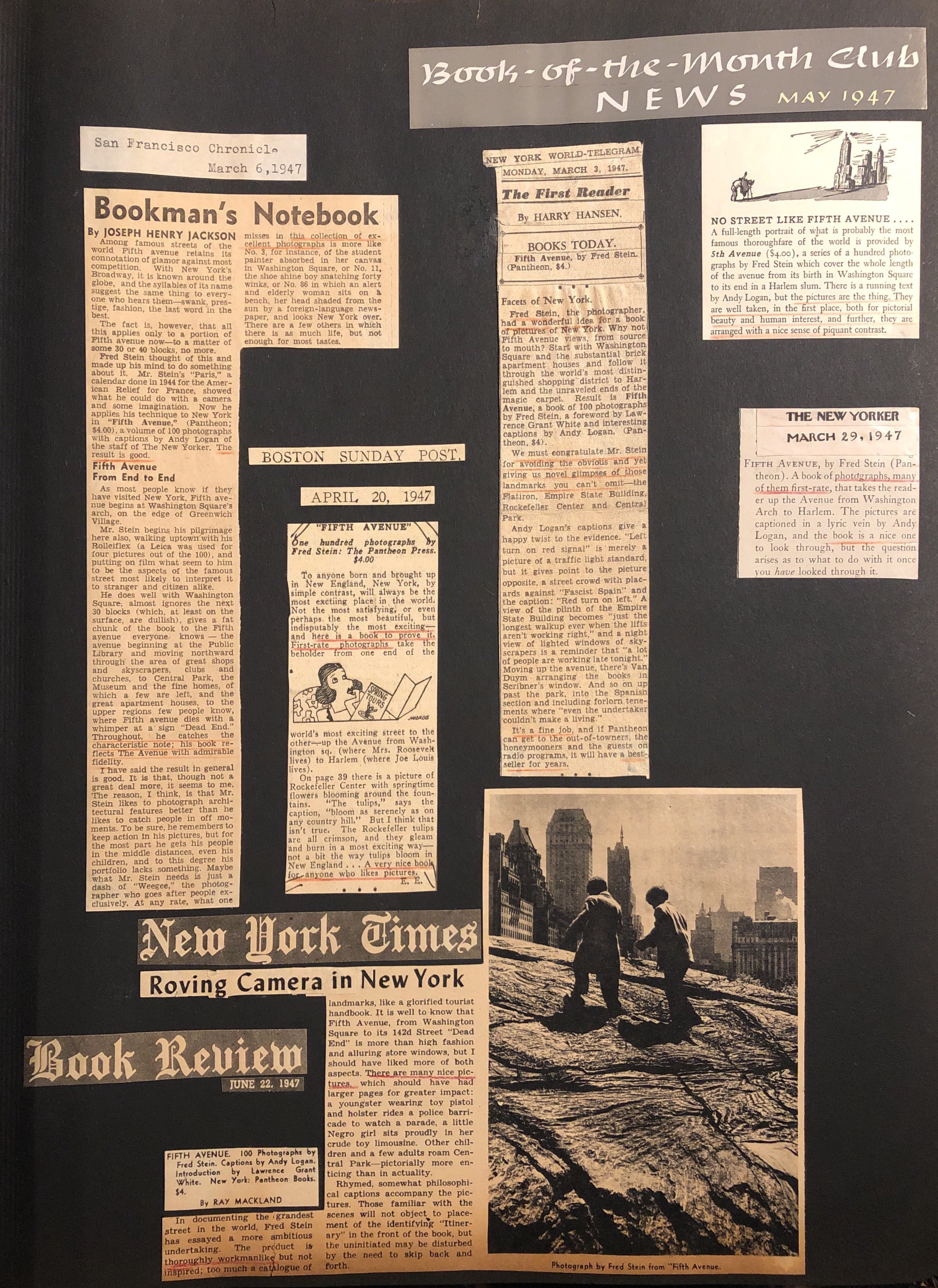
Mixed articles and reviews on 5th Avenue photobook form Fred Stein's scrapbook (© Fred Stein Archive). 
Portrait of Fritz H. Landshoff (of Querido Publishing House) by Fred Stein, 1944 (© Fred Stein Archive). 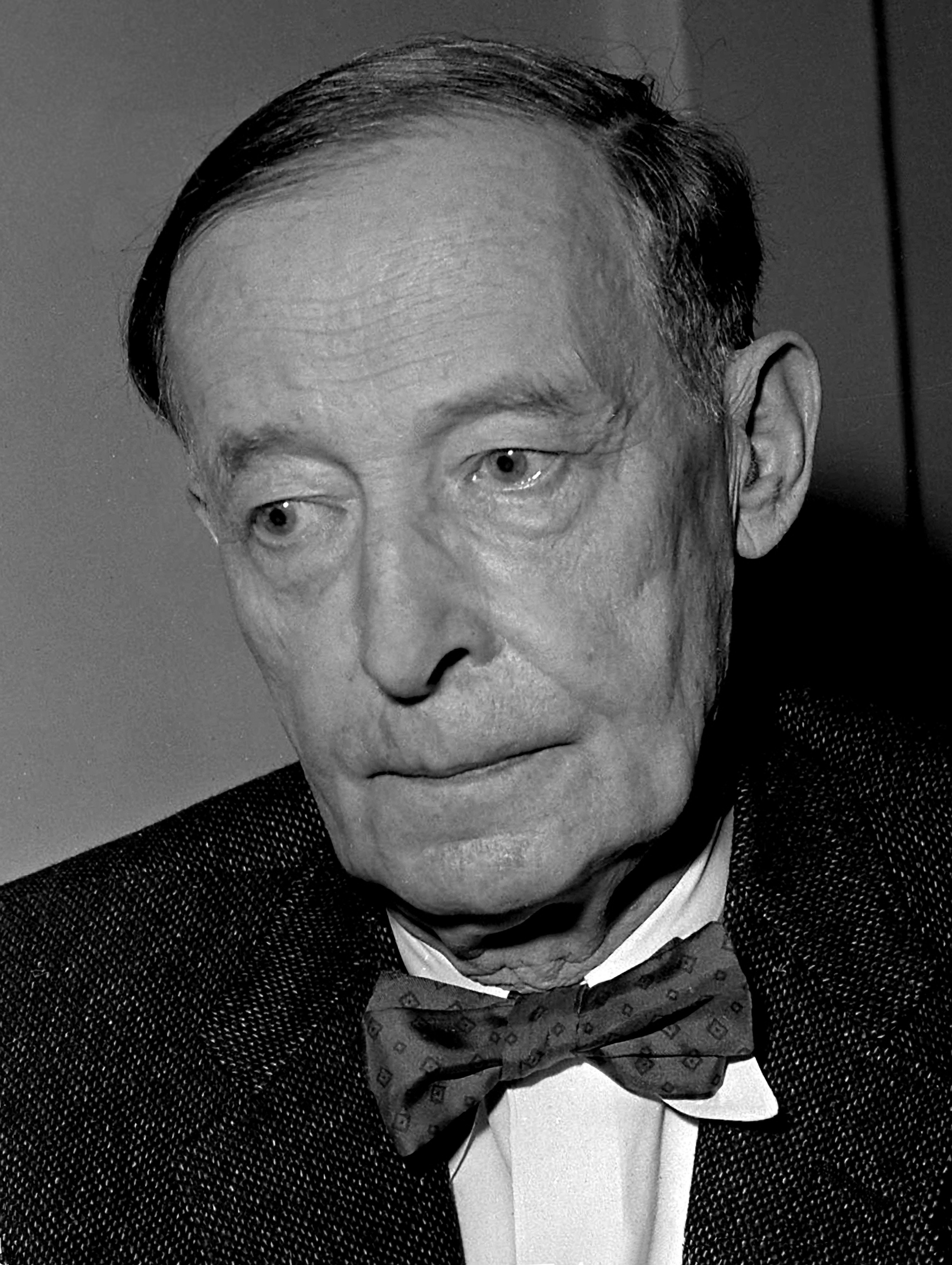
Portrait of Kurt Wolff (of publishing house Pantheon Books) by Fred Stein, 1959 (© Fred Stein Archive). 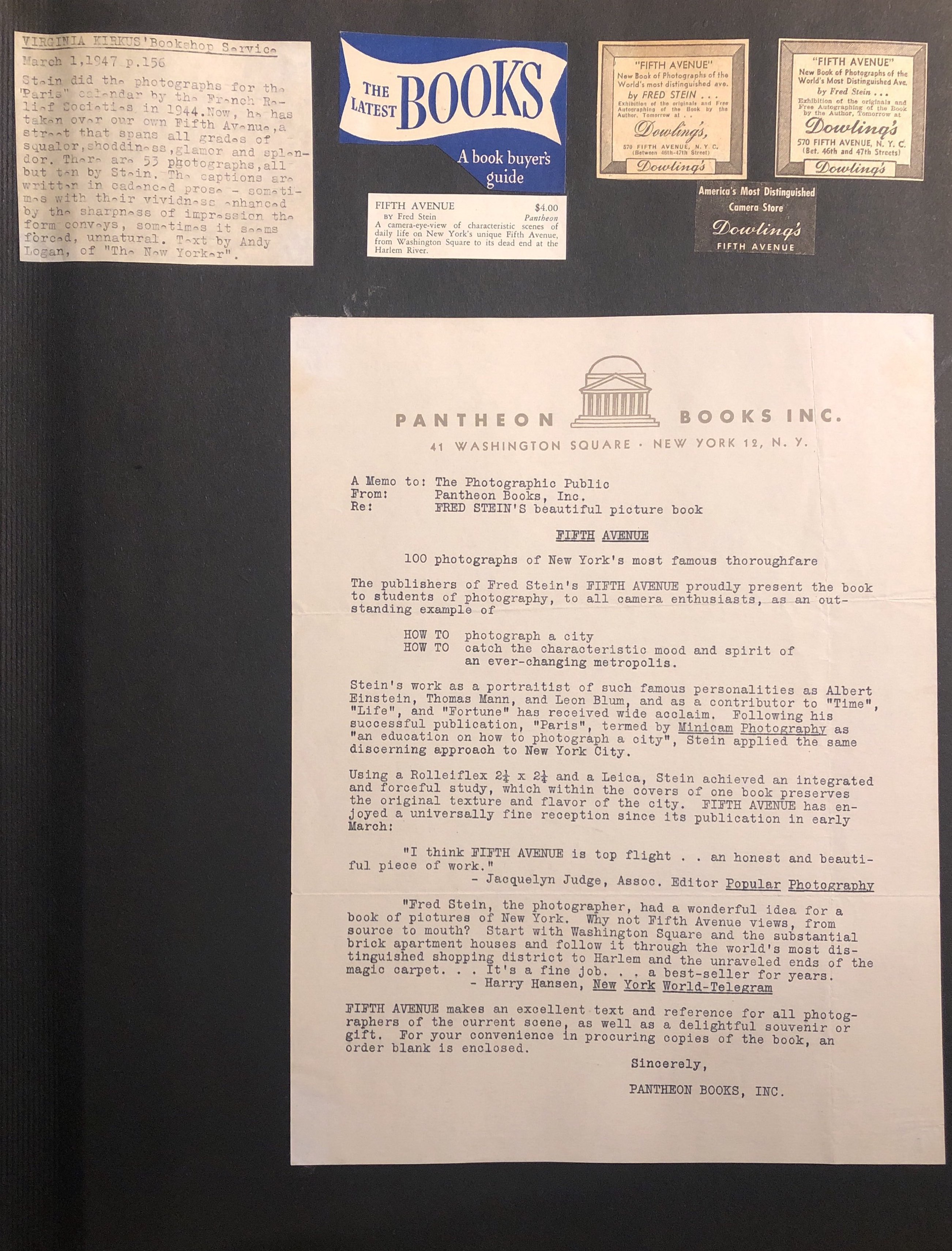
Announcement by Pantheon Books from Fred Stein’s scrapbook (© Fred Stein Archive). 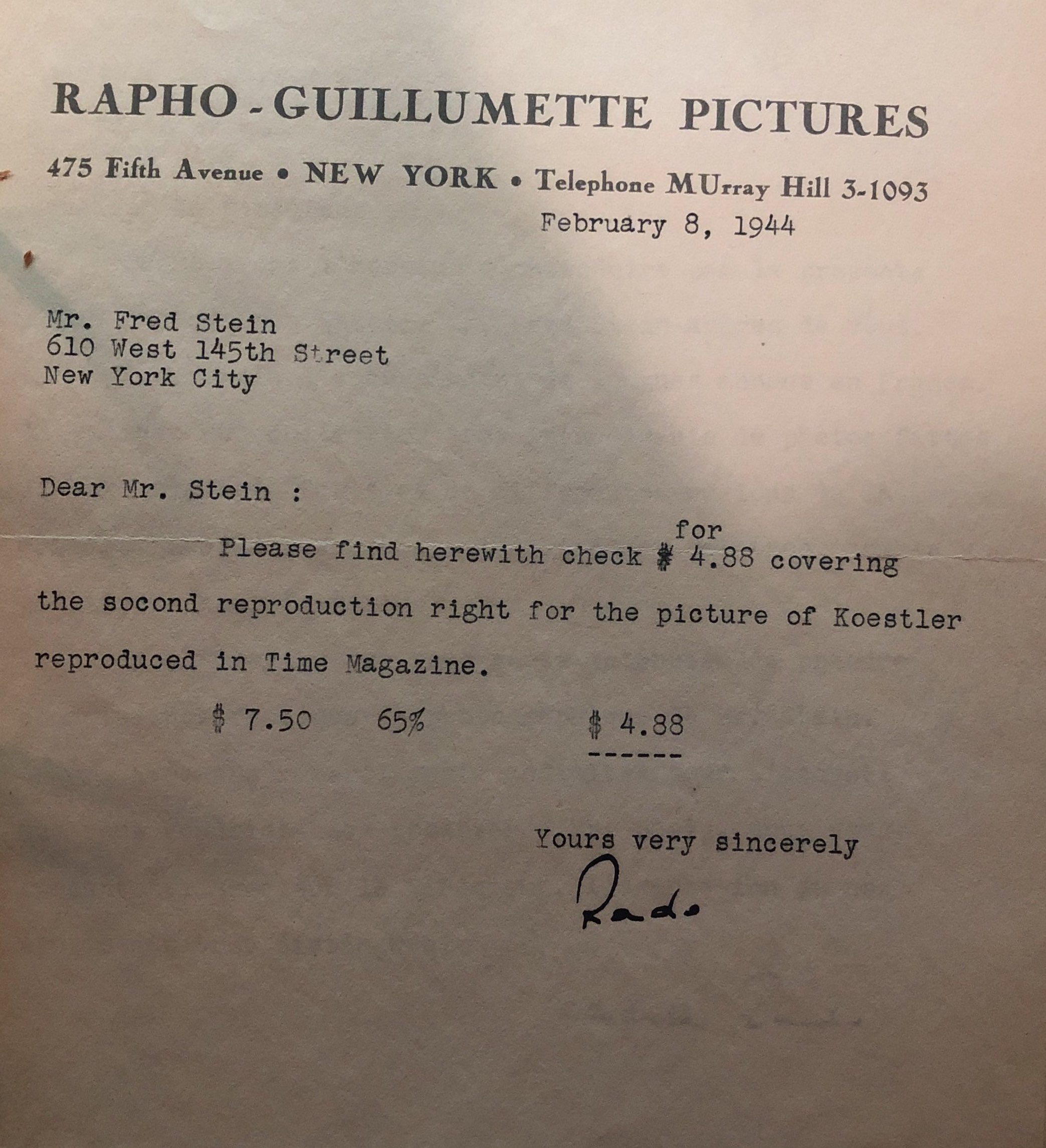
Rapho Guillumette agency letter to Fred Stein, 1944 (© Fred Stein Archive). 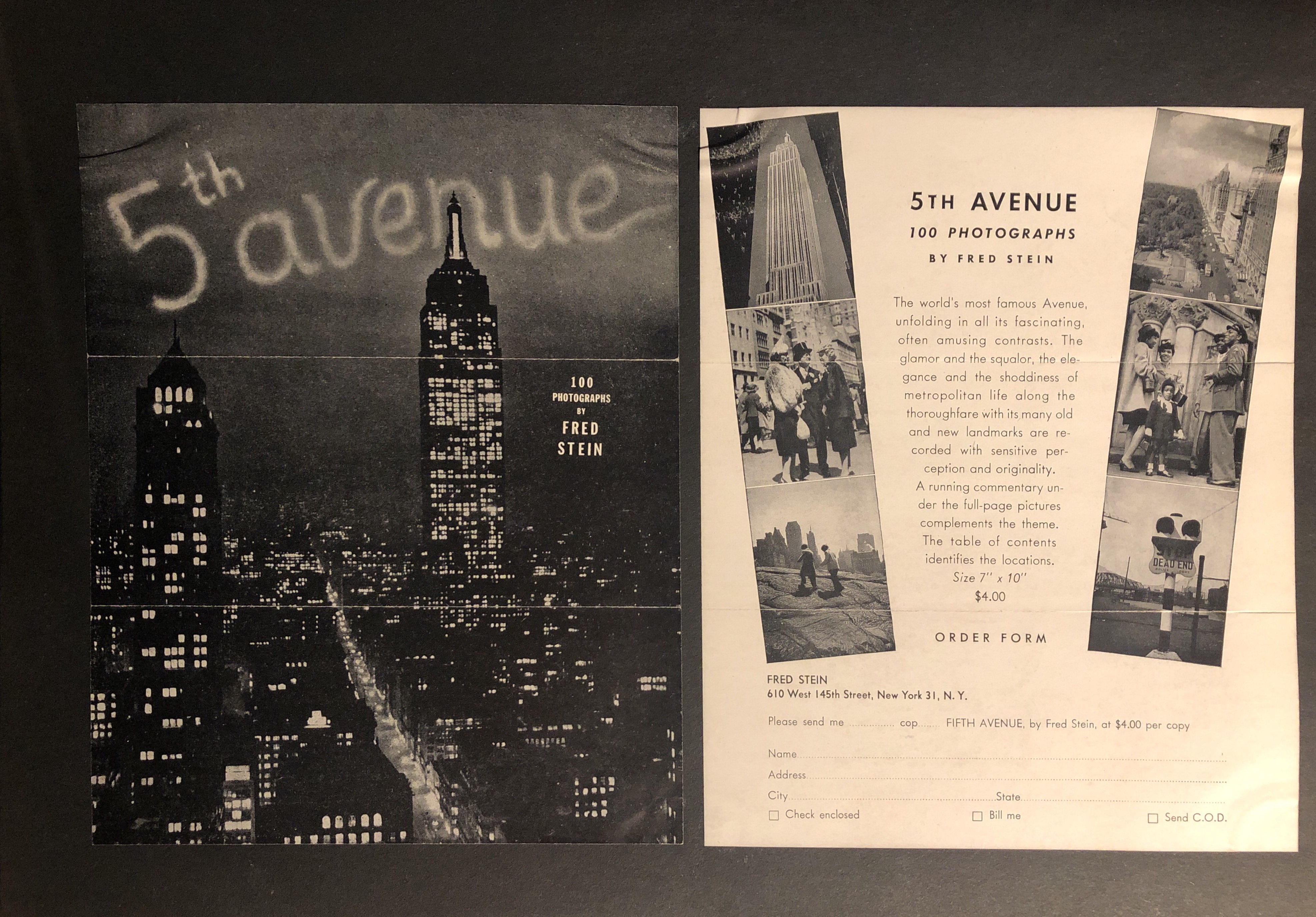
Cover of 5th Avenue photobook (Pantheon Books, 1947) by Fred Stein (© Fred Stein Archive). Craener, Vera. "Ein immigrant entdeckt New York. Fred Steins Weg zum Erfolg." Aufbau, 9 May, 1947, p. 27.
Displaced Visions. Émigré Photographers of the 20th Century, edited by Nissan N. Perez, exh. cat. The Israel Museum, Jerusalem, 2013.
Eyes on Paris. Paris im Fotobuch 1890 bis heute, edited by Hans-Michael Koetzle, exh. cat. Haus der Photographie in den Deichtorhallen, Hamburg, 2011.
Fred Stein. Dresden, Paris, New York, edited by Erika Eschebach and Helena Weber, exh. cat. Stadtmuseum Dresden, Dresden, 2018.
Fred Stein. Paris New York, edited by Dawn Freer, exh. cat. Jewish Museum Berlin, Berlin, 2013.
Neugass, Fritz. “The saga of the S.S. Winnipeg.” Modern Photography, July 1951, pp. 72–75; 86; 88.
Schaber, Irme. “Fotografie.” Handbuch der deutschsprachigen Emigration 1933–1945, edited by Claus-Dieter Krohn and Patrick von zur Mühlen, WBG, 1998, pp. 970–983.
Schaber, Irme. “‘Die Kamera ist ein Instrument der Entdeckung…’. Die Großstadtfotografie der fotografischen Emigration in der NS-Zeit in Paris, London und New York.” Exilforschung. Ein internationales Jahrbuch, vol. 20: Metropolen des Exils, edited by Claus-Dieter Krohn, edition text + kritik, 2002, pp. 53–73.
Stein, Fred. 5th Avenue. 100 Photographs. Pantheon, 1947.
Word Count: 166
Deutsche Nationalbibliothek, Deutsches Exilarchiv 1933–1945, Frankfurt am Main.
"Fred Stein.“ WeRefugees Archive. Digitales Archiv zu Flucht in Vergangenheit und Gegenwart.
Künste im Exil / Arts in Exile, Deutsches Exilarchiv 1933–1945, Frankfurt am Main.
Word Count: 34
My deepest thanks go to Peter Stein, the son of Fred Stein, for providing me with information on and material by Fred Stein.
Word Count: 23
Paris, France (1933–1939); New York, US (1941-1967).
610 West 145 Street, Hamilton Heights, Manhattan, New York City (residence and studio, 1941–1952); 420 Lexington Avenue, Black Star Office, Midtown Manhattan, New York (workplace, 1943–1950s); 645 West 160 Street, Washington Heights, Manhattan, New York City (residence and studio, 1952–1964); 38 East 65th Street, Lennox Hill, New York City (temporary studio, 1940s?); 119 West 57th Street, Central Park South, Manhattan, New York City (temporary studio, 1950s?).
- New York
- Helene Roth. "Fred Stein." METROMOD Archive, 2021, https://archive.metromod.net/viewer.p/69/2948/object/5138-8104113, last modified: 06-09-2022.
-
Hermann LandshoffPhotographerNew York
Besides outdoor fashion shots, Hermann Landshoff was a portrait and street photographer. During his time in New York, he captured the cultural, artistic and intellectual émigré scene as well as his photographer colleagues.
Word Count: 33
Walter SandersPhotographerNew YorkWalter Sanders was a German émigré photographer. In 1938 he arrived in New York, where he worked from 1939 until the end of his life for the Black Star agency and, from 1944, for Life magazine.
Word Count: 33
Kurt SafranskiPicture AgentFounding MemberTeacherCartoonistPublisherIllustratorNew YorkKurt Safranski was one of the founding members of the Black Star photo agency, a teacher at the New School for Social Research and the author of photojournalistic articles and books.
Word Count: 31
Josef BreitenbachPhotographerNew YorkOn arriving in New York in 1941, the German photographer Josef Breitenbach tried to restart as a portrait, street and experimental photographer, as well as a teacher of photo-history and techniques.
Word Count: 30
Andreas FeiningerPhotographerWriterEditorNew YorkAndreas Feininger, was a German émigré photographer who arrived in New York with his wife Wysse Feininger in 1939. He started a lifelong career exploring the city's streets, working as a photojournalist and writing a large number of photography manuals.
Word Count: 39
Lisette ModelPhotographerNew YorkLisette Model was an Austrian-born photographer who lived in New York with her husband Evsa Model after emigrating from France. Her street photographs capturing the curiosities of everyday life quickly caught the interest of museums and magazines.
Word Count: 37
Charles LeirensPhotographerMusicianMusicologistNew YorkCharles Leirens was a Belgian-born musician and photographer who emigrated to New York in 1941. While publishing two books on Belgian music, he also gave courses in musicology and photography at the New School for Social Research.
Word Count: 36
Rolf TietgensPhotographerEditorWriterNew YorkRolf Tietgens was a German émigré photographer who arrived in New York in 1938. Although, in the course of his photographic career, his artistic and surrealist images were published and shown at exhibitions, his work, today, is very little known.
Word Count: 39
Tim GidalPhotographerPublisherArt HistorianNew YorkTim Gidal was a German-Jewish photographer, publisher and art historian emigrating in 1948 emigrated to New York. Besides his teaching career, he worked as a photojournalist and, along with his wife Sonia Gidal, published youth books.
Word Count: 35
YllaPhotographerNew YorkYlla was an Austrian-born photographer who emigrated to New York in 1941. Specialising in animal photography, she produced not only studio photographs, but also shot outside on urban locations in the metropolis.
Word Count: 31
Fritz HenlePhotographerNew YorkFritz Henle was a German Jewish photographer who emigrated in 1936 to New York, where he worked as a photojournalist for various magazines. He also published several photobooks of his travels throughout North America and Asia.
Word Count: 35
Kurt KornfeldPublisherPicture AgentFounding MemberNew YorkKurt Kornfeld was a publisher and literary agent and a founding member of the Black Star photo agency in New York City after his emigration in 1936 to New York.
Word Count: 29
Ernest MayerPicture AgentFounding MemberPublisherNew YorkErnest Mayer was co-founder of the Black Star Publishing Company photo agency, which built a network for émigré photographers and the American magazine scene from the mid-1930s until the end of the 1950s.
Word Count: 34
Carola GregorPhotographerSculptorNew YorkThe German émigré photographer Carola Gregor was an animal and child photographer and published some of her work in magazines and books. Today her work and life are almost forgotten.
Word Count: 30
Rudy BurckhardtPhotographerFilmmakerPainterNew YorkRudy Burckhardt was a Swiss-born photographer, filmmaker and painter who emigrated from Basle to New York City in 1935. He was well networked within the emerging Abstract Expressionist art scene of 1940s' and 50s'.
Word Count: 33
T. Lux FeiningerPhotographerPainterNew YorkLux T. Feininger was a German-American émigré photographer and painter and the brother of the photographer Andreas Feininger, arriving in 1936 in New York. Although he started taking photographs during the 1920s in Germany, Feininger is better known for his career as a painter and his photographic work is largely unacknowledged.
Word Count: 50
Trude FleischmannPhotographerNew YorkTrude Fleischmann was an Austrian-Jewish portrait and dance photographer who emigrated in 1939 to New York, where she opened a studio in Midtown Manhattan with the photographer Frank Elmer.
Word Count: 28
Henry RoxPhotographerSculptorNew YorkHenry Rox was a German émigré sculptor and photographer who, in 1938, arrived in New York with his wife, the journalist and art historian Lotte Rox (née Charlotte Fleck), after an initial exile in London. Besides his work as a sculptor, he began creating humorous anthropomorphised fruit and vegetable photographs.
Word Count: 50
Manhattan Magic. A collection of eighty-five photographsPhotobookNew YorkManhattan Magic is a photobook which was published in 1937 by the German émigré photographer Mario Bucovich in New York City.
Word Count: 20
New YorkBookPhotobookNew YorkIn 1932, after her remigration to Vienna, the Austrian journalist Ann Tizia Leitich published New York, an account of her life and writing experiences started as an emigrant in New York in the 1920s.
Word Count: 33
Chinatown U.S.A.PhotobookNew YorkChinatown U.S.A. is a photobook published by the German émigré photographer Elizabeth Coleman in 1946 focusing on American-Chinese communities in New York and San Francisco.
Word Count: 26
5th AvenuePhotobookNew York5th Avenue was the first photobook by Fred Stein and was created in 1947 with the publishing house Pantheon Books.
Word Count: 19
Black Star AgencyPhoto AgencyNew YorkThe German émigrés Kurt S(z)afranski, Ern(e)st Mayer and Kurt Kornfeld founded Black Star in 1936. The photo agency established was a well-run networking institution in New York.
Word Count: 31
PIX Publishing Inc.Photo AgencyNew YorkPIX Publishing Inc. was a photo agency founded in New York in 1935 by photo agent Leon Daniel and Celia Kutschuk, together with German émigré photographers Alfred Eisenstaedt and George Karger.
Word Count: 30
J.J. Augustin Incorporated PublisherPublishing HouseNew YorkJ.J. Augustin was a German publishing house in Glückstadt with a long history, going back to 1632. In 1936 the American branch opened in New York with a large artistic and cultural focus.
Word Count: 33
Pantheon BooksPublishing HouseNew YorkPantheon Books was a publishing house founded in 1942 by the German émigré Kurt Wolff (1887–1963) and aimed at the exiled European community in New York.
Word Count: 24
New School for Social ResearchAcademy/Art SchoolPhoto SchoolUniversity / Higher Education Institute / Research InstituteNew YorkDuring the 1940s and 1950s emigrated graphic designers and photographers, along with artists and intellectuals, were given the opportunity to held lectures and workshops at the New School for Social Research.
Word Count: 31
Rapho GuillumettePhoto AgencyNew YorkFounded in 1940 by the emigrant Charles Rado (1899–1970), Rapho Guillumette was a picture agency.
Word Count: 13
Querido Inc.Publishing HouseNew YorkFritz H. Landshoff’s Querido publishing house was originally an offshoot of Emanuel Querido's Querido Uitgeverij Dutch publishing house in Amsterdam. Querido Verlag was created in 1933 to publish work by German political exiles.
Word Count: 33
Werner WolffPhotographerNew YorkWerner Wolff was forced to leave Germany in 1936 due to his Jewish background and emigrated via Hamburg to New York, where he could follow his career as photographer and photojournalist.
Word Count: 30
Ruth BernhardPhotographerNew YorkRuth Bernhard was a German émigré photographer who lived in New York from the 1920s to the 1940s. Beside her series on female nudes, her place in the photography network, as well as in the New York queer scene, is unknown and understudied.
Word Count: 43
Ellen AuerbachPhotographerNew YorkWhen she arrived in New York in 1937, the German-born photographer Ellen Auerbach (formerly Rosenberg) had already passed through exile stations in Palestine and Great Britain.
Word Count: 25
Lilly JossPhotographerNew YorkLilly Joss was an émigré freelance photographer in New York. She worked for the Black Star photo agency and magazines and was also a portrait and theatre photographer.
Word Count: 28